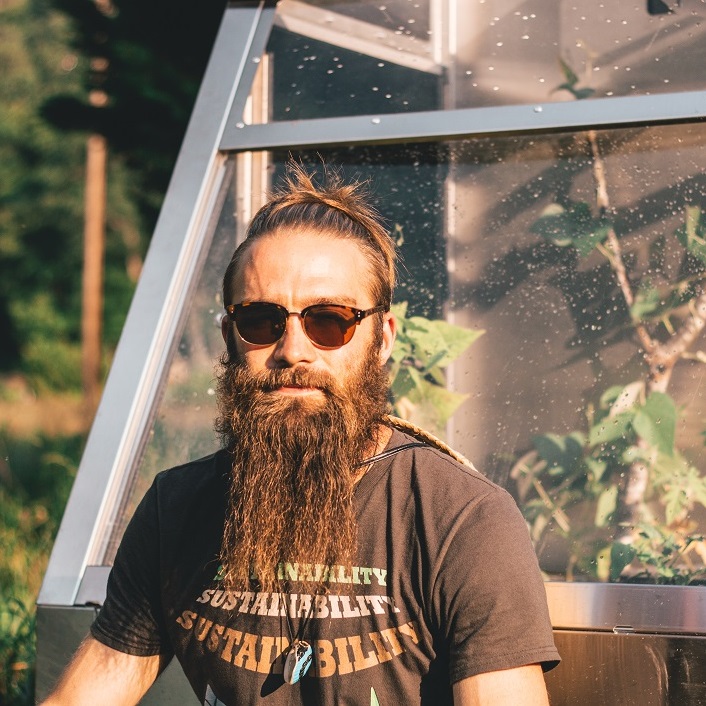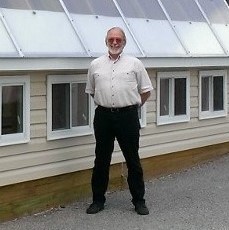To demonstrate typical performance of a SunCatcher, we have installed temperature and light sensors in many of our existing SunCatchers to record and track how they do in various conditions. Some of this data is included below for reference. If you have questions, feel free to contact us!
Laurel Ridge SunCatcher
Weekly Average Temperatures for Winter 2012-2013
The SunCatcher at Laurel Ridge is located in the mountains of Western North Carolina. The graph below represents weekly averages of the inside temperature (blue) of the SunCatcher versus the weekly averages of the outside temperature (red). Convective venting exhausted the excess heat and humidity that built up during sunny days and brought fresh air in for the plants. The SunCatcher maintains a +30°F temperature difference compared with the outside temperature throughout the winter and would perform even better with a nighttime thermal insulation barrier covering the glazing at night to further reduce heat loss.
A Detailed Look at One Week in Winter
The Laurel Ridge SunCatcher experienced one of the coldest nights on February 17, 2013. The day before was very cloudy and the interior temperature (red line) only rose to 70°F. That night the outside temperature plummeted to 3°F (green line), but the interior temperatures only dropped to the 50°F mark. This exemplifies the ability of SunCatchers to retain heat, even on the coldest of nights.
The light green line indicates sunlight intensity, and as an example, shows that February 13 was a mostly cloudy day while February 14 started clear in the morning but later in the day it became cloudy. By looking at sunlight levels each day, you can see how temperature corresponds. For most of the week, the outside temperature was in the 20-40°F range while the interior stayed in the 50-90°F range. This performance did not include the use of a nighttime shade that would insulate the glazing resulting in less heat loss at night which could boost thermal performance by 30%.
During this week, the humidity levels stayed within the 30-70% range (black line).
Parkway SunCatcher
The Parkway SunCatcher was our first Classic model. As you can see by the graph and data table below this “proof of concept” model performed extremely well. In fact, note in the graph below when the outside temperature dropped to 0°F the interior temperature stayed a relatively warm 56°F. As shown in the data table the SunCatcher actually gets ever warmer as the outside temperatures drop below freezing! Also note the difference the night time curtain made between the III and IV periods. Even though the thermal mass was not as well charged (with heat) during (the warmer) fourth period, the SunCatcher maintained the same interior temperatures using the night time shade as the third period which had more heat stored in the thermal mass but did not utilize the night time shade. Overall note the relationship between the temperature and cloud cover and the effect on charging the thermal mass. As it gets colder outside not only does the temperature difference between the interior and outside get larger, but the average interior temperature increases during the colder periods.
The Carolina Mountain SunCatcher
The Carolina Mountain SunCatcher was our first SunCatcher in which Phase Change Material (PCM) was used as the primary thermal mass. While both PCM and water filled metal containers function as thermal mass, they store and release heat in very different ways.
Based on the initial analysis of the data we collected during the very cold winter months of 2014-15, for best overall thermal performance a combination of PCM and water-filled barrels or solar thermal tubes will be recommended for future SunCatchers in very cold climates. This will help keep the temperatures inside the SunCatcher from dropping too low during periods of very cold outside temperatures preceded by several cloudy days in a row. Note that the inside temperature never dropped to freezing with the PCM as the primary thermal mass even with outside temperatures below zero and the plants all flourished. The addition of water-filled metal barrels or solar thermal tubes will add an extra measure of protection to maintain acceptable minimum temperatures during extreme cold and cloudy periods.












